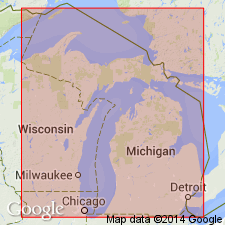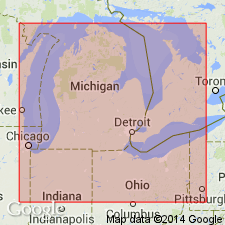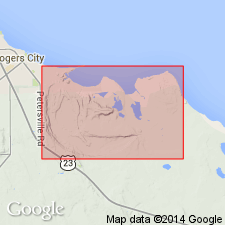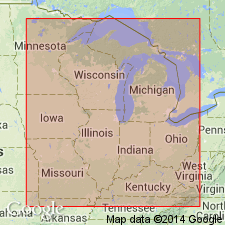
- Usage in publication:
-
- Rogers City limestone
- Modifications:
-
- Named
- Dominant lithology:
-
- Limestone
- Dolomite
- AAPG geologic province:
-
- Michigan basin
Summary:
As proposed, the name Rogers City is applied to limestone and dolomite strata formerly considered part of the Dundee, which is here restricted to lower 140 ft of section. Lower 8 to 9 ft of Rogers City is dolomite; upper part is limestone. Rogers City fauna is distinctive from that of the Dundee. Age is Middle Devonian.
Source: GNU records (USGS DDS-6; Reston GNULEX).

- Usage in publication:
-
- Rogers City Member
- Modifications:
-
- Overview
- AAPG geologic province:
-
- Michigan basin
Summary:
Authors follow usage of Gardner (1974) who divided the Dundee into (ascending) Reed City Member and Rogers City Member. [Reed City has never been formally proposed and is therefore considered informal by the GNU.] The Rogers City is lithologically and paleontologically similar to the coeval subunit II of the Thiensville Formation of WI. The Reed City is not wholly equivalent to subunits I and III of the Thiensville, but was deposited under similar environmental conditions. The Reed City is restricted to the western part of the basin.
Source: GNU records (USGS DDS-6; Reston GNULEX).

- Usage in publication:
-
- Rogers City Limestone
- Modifications:
-
- Overview
- AAPG geologic province:
-
- Michigan basin
Summary:
A new species of gastropod from the genus PORCELLIA is described from the Middle Devonian Rogers City Limestone. The Rogers City crops out in the northeastern part of the Michigan basin for about 50 km from Middle Island near Rockport Quarry to just west of Rogers City, where it disappears beneath glacial cover. It is quarried extensively because of its pure chemical quality. Unit is about 21 m thick and was subdivided into six numbered units by Ehlers and Kesling (1970). Units 1 and 2 (supratidal deposits) are dolostones, 3 and 4 (back-reef lagoonal deposits) are fine-grained limestones with a depauperate fauna, and units 5 and 6 (reef) are very coarse-grained limestone with a very diverse fauna dominated by corals, stromatoporoids, bryozoans, and gastropods. PORCELLIA has been found only in Unit 1, the basal dolostone. The fauna of the Rogers City is dissimilar from that of the underlying Dundee Limestone and also from that of the overlying Traverse Group, both of which can be correlated with sections of the Appalachian basin. The fauna of the Rogers City, however, correlates with the fauna of Germany, Manitoba, and western North America.
Source: GNU records (USGS DDS-6; Reston GNULEX).

- Usage in publication:
-
- Rogers City Formation*
- Modifications:
-
- Biostratigraphic dating
- AAPG geologic province:
-
- Michigan basin
Summary:
A single specimen of the lower Givetian coral APHROIDOPHYLLUM n. sp. is known from Rogers City Formation in northeast part of Michigan's Lower Peninsula.
Source: GNU records (USGS DDS-6; Reston GNULEX).
For more information, please contact Nancy Stamm, Geologic Names Committee Secretary.
Asterisk (*) indicates published by U.S. Geological Survey authors.
"No current usage" (†) implies that a name has been abandoned or has fallen into disuse. Former usage and, if known, replacement name given in parentheses ( ).
Slash (/) indicates name conflicts with nomenclatural guidelines (CSN, 1933; ACSN, 1961, 1970; NACSN, 1983, 2005, 2021). May be explained within brackets ([ ]).

